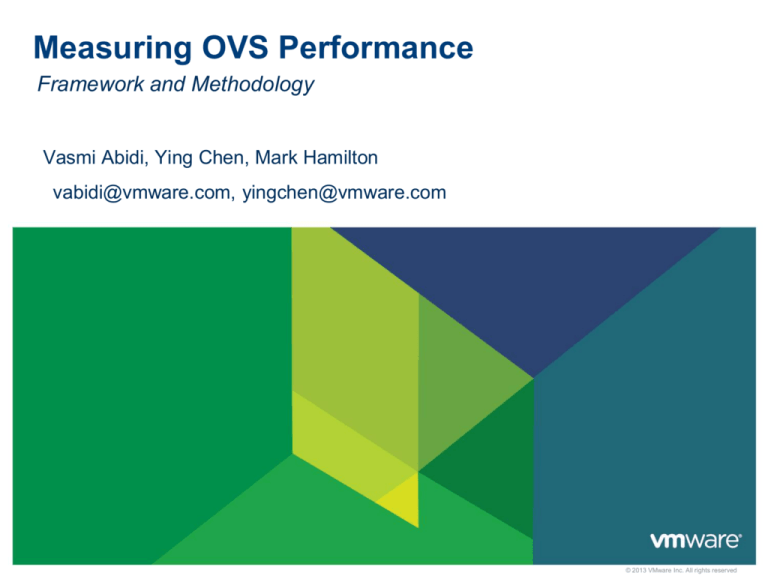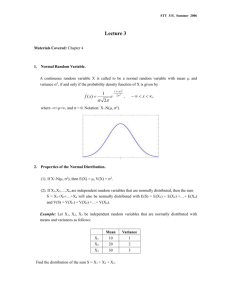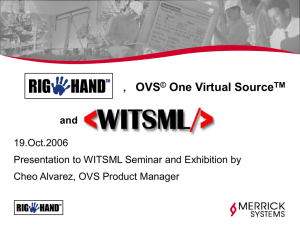
Measuring OVS Performance
Framework and Methodology
Vasmi Abidi, Ying Chen, Mark Hamilton
vabidi@vmware.com, yingchen@vmware.com
© 2013 VMware Inc. All rights reserved
Agenda
Layered performance testing methodology
• Bridge
• Application
Test framework architecture
Performance tuning
Performance results
2
What affects “OVS Performance”?
Unlike a Hardware switch, performance of OVS is dependent on its environment
CPU Speed
• Use a fast CPU
• Use “Performance Mode” setting in BIOS
• NUMA considerations e.g. number of cores per NUMA node
Type of Flows (rules)
• Megaflows rules are more efficient
Type of traffic
• TCP vs UDP
• Total number of flows
• Short-lived vs long-lived flows
NIC capabilities
• Number of queues
• RSS
• Offloads – TSO, LRO, cksum, tunnel offloads
vNIC Driver
In application-level tests, vhost may be bottleneck
3
Performance Test Methodology
Bridge Layer
4
Bridge Layer: Topologies
Simple loopback
Simple Bridge
Linux Host
OVS
Host0
Host1
OVS
OVS
L2 Switch Fabric
Port1
Tx
L2 Switch Fabric
Port2
Rx
Spirent Test Center
Port2
Rx
Port1
Tx
Spirent Test Center
Topology1
5
Topology1 is a simple loop through hypervisor OVS
Topology2 includes tunnel between Host0 and Host1
No VMs in these topologies
Can simulate VM endpoints with physical NICs
Topology2
Bridge Layer: OVS Configuration for RFC2544 tests
Test Generator wizards typically use configurations (e.g. ‘learning
phase’) which are more appropriate for hardware switches
For Spirent, there is an non-configurable delay between learning
phase and test phase
Default flow max-idle is shorter than the above delay
• Flows will be evicted from kernel cache
Flow miss in kernel cache affects measured performance
Increase the max-idle on OVS
ovs-vsctl set Open_Vswitch . Other_config:max-idle=50000
Note: this is not performance tuning. It is to accommodate the test
equipment’s artificial delay after the learning phase
6
Performance Test Methodology
Application Layer
7
Application-based Tests Using netperf
Host1
Host0
VM1
VM1
VM8
OVS1
VM8
KVM
OVS2
KVM
L2 Switch
Fabric
• netperf in VM1 on Host0 connects to netserver on VM1 on Host1
• Test traffic is VM-to-VM, upto 8 pairs concurrently, uni and
bidirectional
• Run different testsuites: TCP_STREAM, UDP_STREAM, TCP_RR,
TCP_CRR, ping
8
Logical Topologies
• Bridge – no tunnel encapsulation
• STT tunnel
• VXLAN tunnel
9
Performance Metrics
10
Performance Metrics
Throughput
• Stateful traffic is measured in Gbps
• Stateless traffic is measured in Frames per Second (FPS)
o Maximum Loss Free Frame Rate as defined in RFC2544 (MLFFR)
o Alternatively, Tolerate Frame Loss Threshold, e.g. 0.01%
Connections Per Second
• Using netperf –t TCP_CRR
Latency
• Application level round-trip latency in usec using netperf –t TCP_RR
• Ping round-trip latency in usec using ping
CPU Utilization
• Aggregate CPU Utilizations on both hosts
• Normalized by Gbps
11
Measuring CPU Utilization
Tools like top under-report for interrupt-intensive workloads
We use perf stat to count cycles & instructions
Run perf stat during test
perf stat -a -A -o results.csv -x, -e cycles:k,cycles:u,instructions sleep <seconds>
Use nominal clock speed to calculate CPU % from cycle count
Record cycles/instruction
12
What is “Line rate”?
Maximum rate at which user data can be transferred
Usually less than raw link speed
because of protocol overheads
Example: VXLAN-encapsulated packets
13
Performance Metrics: variance
Determine variation from run to run
Choose acceptable tolerance
14
Testing Architecture
15
Automation Framework Goals & Requirements
Provide independent solutions to do:
•
•
•
•
•
System setup and baseline
Upgrade test components
Orchestration of Logical network topology, with and without Controllers
Manage tests and execution
Report generation - processing test data
Provide system setup and baseline to the community
• System configuration is a substantial task
Leverage open source community
100% automation
16
Automation Framework: Solutions
Initial system setup and baseline
Ansible
• Highly reproducible environment
• Install a consistent set of Linux packages
• Provide template to the community
Upgrade test components
Ansible
• Installing daily builds onto our testbed e.g. openvswitch
Logical network topology configuration
Ansible
• Attaching VMs and NICS, configure bridges, controllers, etc
Test management and execution
• Support hardware generators
Ansible, Nose, Fabric
Testcenter Python libraries
• netperf
• Extract system metrics
Report generation, validate metrics
Save results
17
django-graphos & Highchart
Django
Framework Component: Ansible
Ansible is a pluggable architecture for system configuration
• System information is retrieved then used in a playbook to govern changes
that are applied to a system
Already addresses major system level configuration
• Installing drivers, software packages etc across various Linux Flavors
Agentless – needs only ssh support on SUT (System Under Test)
Tasks can be applied to SUTs in parallel, or forced to be sequential
Rich template support
Supports idempotent behavior
• OVS is automation-friendly, because of CRUD behavior
It’s essentially all Python – easier to develop and debug
Our contributions to Ansible: modules openvswitch_port,
openvswitch_bridge, openvswitch_db
Ansible website http://www.ansible.com/home
18
Performance Results
19
System Under Test
Dell R620 2 sockets, each with 8 cores, Sandy bridge
Intel Xeon E5-2650v2 @ 2.6GHz, L3 Cache 20MB, mem 128GB
Ubuntu 14.04 64-bit with several system level configurations
OVS version 2.3.2
Use kernel OVS
NIC - Intel X540-AT2 ixgbe version 3.15.1-k
• 16 queues, because there are 16 cores
(Note: # of queues and affinity settings are NIC-dependent)
20
Testbed Tuning
VM Tuning
•
•
•
•
Set cpu model to match the host
2 MB huge pages, no sharing locked
Use ‘vhost’, a kernel backend driver
21
<cpu mode='custom' match='exact'>
<model fallback='allow'>SandyBridge</model>
<vendor>Intel</vendor>
</cpu>
<vcpu placement='static’>2</vcpu>
Disable irqbalance
<memtune>
<hard_limit>2097152</hard_limit>
</memtune>
<memoryBacking>
<hugepages/>
<locked/>
<nosharepages/>
</memoryBacking>
Affinitize NIC queues to cores
<driver name='vhost' queues='2'/>
Set swappiness to 0
Host /etc/sysctl.conf
2 vCPU, with 2 vnic queues
Host tuning
•
•
•
•
•
•
VM XML
BIOS is in “Performance” mode
Disable zone reclaim
Disable arp_filter
vm.swappiness=0
vm.zone_reclaim_mode=0
net.ipv4.conf.default.arp_filter=1
Bridge Layer: Topologies
Simple loopback
Simple Bridge
Host0
Host1
OVS
OVS
OVS
L2 Switch Fabric
L2 Switch Fabric
Linux Host
Port1
Tx
Port2
Rx
Spirent Test Center
Port2
Rx
Port1
Tx
Spirent Test Center
Topology1
Topology1 is a simple loop through hypervisor OVS
Topology2 includes tunnel between Host0 and Host1
No VMs in these topologies
Can simulate VM endpoints with physical NICs
22
Topology2
Bridge Layer: Simple Loopback Results
Throughput (Gbps) vs Frame Size for Loopback
14000
12.0
12000
10.0
Throughput (Gbps)
Throughput (KFPS)
Throughput (KFPS) vs Frame Size for Loopback
10000
8000
6000
4000
2000
0
8.0
6.0
4.0
2.0
0.0
64
128
1 core NUMA
256
512
Frame Size (bytes)
8 cores NUMA
1024
16 cores
1514
64
128
1 core NUMA
256
512
Frame Size (bytes)
8 cores NUMA
1024
16 cores
1 and 8 cores NUMA results only use cores on the same NUMA
node as the NIC
Throughput scales well per core
Your mileage may vary depending on system, NUMA architecture
NIC manufacturer etc.
23
1514
Bridge Layer: Simple Bridge Results
Throughput (Gbps) vs Frame Size for Simple Bridge
12000
12.0
10000
10.0
Throughput (Gbps)
Throughput (KFPS)
Throughput (KFPS) vs Frame Size Simple Bridge
8000
6000
4000
2000
0
8.0
6.0
4.0
2.0
0.0
64
128
1 core NUMA
256
512
Frame Size (bytes)
8 cores NUMA
1024
1514
16 cores
64
128
1 core NUMA
256
512
Frame Size (bytes)
8 cores NUMA
1024
1514
16 cores
For 1-core and 8-core cases, CPUs are on same NUMA node as NIC
Results are similar to simple loopback
Ymmv. Depends on system architecture, NIC type, …
24
Application-based Tests
Host1
Host0
VM1
VM1
VM8
OVS1
VM8
KVM
OVS2
KVM
L2 Switch
Fabric
• netperf in VM1 on Host0 connects to netserver on VM1 on Host1
• Test traffic is VM-to-VM, upto 8 pairs concurrently, uni and
bidirectional
• Run different testsuites: netperf TCP_STREAM, UDP_STREAM,
TCP_RR, TCP_CRR, ping
25
netperf TCP_STREAM with 1 VM pair
Topology
stt
vxlan
vlan
stt
vlan
vxlan
stt
vlan
vxlan
Conclusions
• for 64B, sender CPU bound
• for 1500B, vlan & stt are sender CPU bound
• vxlan throughput is poor. Because no hw offload, CPU cost is high
26
Throughput
Msg Size
Gbps
64
1.01
64
0.70
64
0.80
1500
9.17
1500
7.03
1500
2.00
32768
9.36
32768
9.41
32768
2.00
netperf TCP_STREAM with 8 VM pairs
Topology
vlan
stt
vxlan
vlan
stt
vxlan
Conclusions:
• For 64B, sender CPU consumption is higher
• For large frames, receiver CPU consumption is higher
For given Throughput, compare CPU consumption
27
Throughput 8 VMs
Msg Size
Gbps
64
6.70
64
6.10
64
6.48
1500
9.42
1500
9.48
1500
9.07
netperf bidirectional TCP_STREAM with 1 VM pair
Bidirectional Throughput 1 VMs
Topology
Msg Size
Gbps
stt
64
2.89
vlan
64
3.10
stt
1500
17.20
Topology
vlan
stt
stt
28
1 VM
Msg Size
CPU (%)/Gbps
Host 0 Host 1
64
121
121
64
167
155
other
15
15
Conclusion:
Throughput is twice unidirectional
netperf bidirectional TCP_STREAM with 8 VM pairs
Bidirectional Throughput 8 VMs
Topology
Msg Size
Gbps
vlan
64
17.85
stt
64
17.3
vlan
1500
18.4
vlan
1500
18.7
Topology
vlan
stt
vxlan
vlan
stt
29
8 VM
Msg Size
CPU (%)/Gbps
Host 1 Host 2
64
69
64
75
64 118
1500
65
1500
53
69
75
118
65
53
Note:
• Symmetric CPU utilization
• Large frames, STT utilization is the lowest
Testing with UDP traffic
UDP results provide some useful information
• Frame per second
• Cycles per frame
Caveat: Can result in significant packet drops if traffic rate is high
Use packet-generator that can control offered load, e.g. ixia/spirent
Avoid fragmentation of large datagrams
30
Latency Using netperf TCP_RR
•
•
•
31
Transactions/sec for 1-byte request-response
over persistent connection
Good estimate of end-to-end RTT
Scales with number of VMs
CPS Using netperf TCP_CRR
CPS vs Number of VMs and Sessions
90000
80000
70000
Multiple concurrent flows
CPS
60000
50000
40000
1 VM
30000
8 VM
20000
10000
0
1
Topology
vlan
4
8
16
32
Number of Sessions Per VM
Session 1 VM
64
26 KCPS
64
128
8 VMs
113 - 118 KCPS
stt
64
25 KCPS
83 - 115 KCPS
vxlan
64
24 KCPS
81 - 85 KCPS
Note: results are for the ‘application-layer’ topology
32
Summary
Have a well-established test framework and methodology
Evaluate performance at different layers
Understand variations
Collect all relevant hw details and configuration settings
33
34








